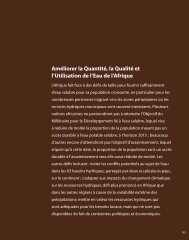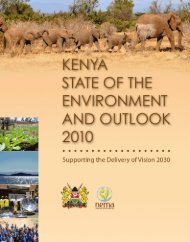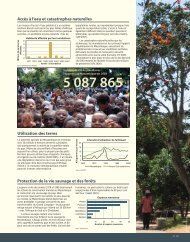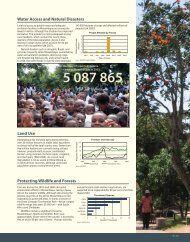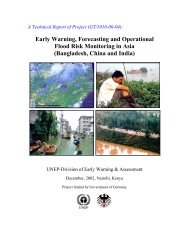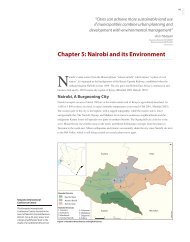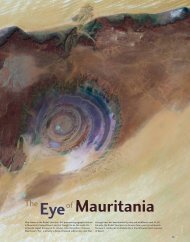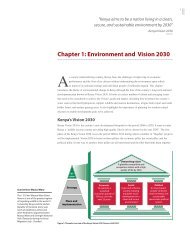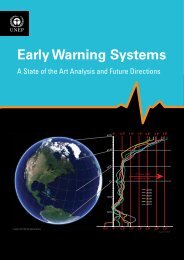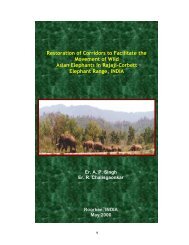Uganda Atlas of Our Changing Environment - GRID-Arendal
Uganda Atlas of Our Changing Environment - GRID-Arendal
Uganda Atlas of Our Changing Environment - GRID-Arendal
Create successful ePaper yourself
Turn your PDF publications into a flip-book with our unique Google optimized e-Paper software.
Kooki hills in Kibaale-Bukoora, Rakai District<br />
The degraded hills <strong>of</strong> Kooki in Rakai District<br />
The most common morphology <strong>of</strong> the hills comprise <strong>of</strong><br />
round to flat summits that abruptly descend on steep<br />
convex and straight slopes, ending in relatively gentle and<br />
moderately concave pediments. The pediment slopes show<br />
an abrupt steepening in their lower sections adjacent to<br />
valley floors which are <strong>of</strong>ten swampy.<br />
Gemorphologically, Kooki hills are thought to result<br />
from an upwarped Buganda plateau during early<br />
Tertiary, after a long quiescence from the Karoo era<br />
and subsequent reduction <strong>of</strong> the plateau landscape by<br />
denudation process to a very low relief, the African<br />
Surface in this Buganda part <strong>of</strong> <strong>Uganda</strong> which, therefore,<br />
is sometimes called Buganda surface. The uplift resulted in<br />
an elevated and dissected plateau consisting <strong>of</strong> a series <strong>of</strong><br />
flat-topped hills or their remnants and intervening valleys.<br />
Thus, the landscape was dissected by the rejuvenated<br />
drainage system, leading to a dissected plateau in form <strong>of</strong><br />
the present ridges and hills. In some cases, the Kooki hills<br />
are related to the Kigezi-Ankole surfaces (highlands), but<br />
generally, Rakai hills are regarded as an upwarping <strong>of</strong> the<br />
Buganda surface.<br />
82<br />
The soils in the Kooki area are dominantly <strong>of</strong> Ferralsols<br />
type and its associations. This is the most dominant<br />
soil type in <strong>Uganda</strong>, covering about 2/3 <strong>of</strong> the country.<br />
This is a class <strong>of</strong> soils considered to be the oldest on<br />
earth; the soils are characterized by low fertility levels<br />
and are deeply weathered and leached with little<br />
mineral reserves remaining. Generally, soil distribution<br />
varies with slope morphology, in that at the summits,<br />
moderately deep to shallow soils <strong>of</strong>ten occur; but on<br />
the steep convex and straight slopes, soils become very<br />
thin with depths varying from bare rocky or weathered<br />
regolith surfaces to only a few centimeters deep. Further<br />
down on the concave and pediment slopes, respectively,<br />
soil depths increase appreciably <strong>of</strong>ten reaching depths <strong>of</strong><br />
over 150 cm.<br />
On the hill summits and steep upper and middle slopes,<br />
the soils are Plinthic Ferralsols and Hyperskeletic<br />
Leptosols. These associations are dominantly shallow,<br />
loose and skeleteral, with high proneness to erosion.<br />
Most <strong>of</strong> the former summit laterite capping has been<br />
removed leaving behind disintegrating boulders and relics<br />
Rakai District Local Administration (2007)



